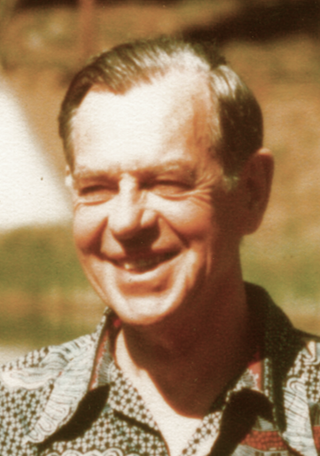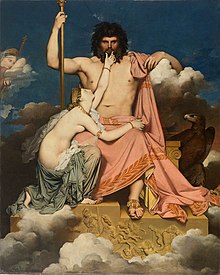
Joseph John Campbell was an American writer. He was a professor of literature at Sarah Lawrence College who worked in comparative mythology and comparative religion. His work covers many aspects of the human experience. Campbell's best-known work is his book The Hero with a Thousand Faces (1949), in which he discusses his theory of the journey of the archetypal hero shared by world mythologies, termed the monomyth.

In ancient Greek mythology and religion, Persephone, also called Kore or Cora, is the daughter of Zeus and Demeter. She became the queen of the underworld after her abduction by her uncle Hades, the king of the underworld, who would later also take her into marriage.

In Greek mythology, Python was the serpent, sometimes represented as a medieval-style dragon, living at the center of the Earth, believed by the ancient Greeks to be at Delphi.

A dying-and-rising, death-rebirth, or resurrection deity is a religious motif in which a god or goddess dies and is resurrected. Examples of gods who die and later return to life are most often cited from the religions of the ancient Near East. The traditions influenced by them include the Greco-Roman mythology. The concept of a dying-and-rising god was first proposed in comparative mythology by James Frazer's seminal The Golden Bough (1890). Frazer associated the motif with fertility rites surrounding the yearly cycle of vegetation. Frazer cited the examples of Osiris, Tammuz, Adonis and Attis, Zagreus, Dionysus, and Jesus.

Religious practices in ancient Greece encompassed a collection of beliefs, rituals, and mythology, in the form of both popular public religion and cult practices. The application of the modern concept of "religion" to ancient cultures has been questioned as anachronistic. The ancient Greeks did not have a word for 'religion' in the modern sense. Likewise, no Greek writer known to us classifies either the gods or the cult practices into separate 'religions'. Instead, for example, Herodotus speaks of the Hellenes as having "common shrines of the gods and sacrifices, and the same kinds of customs."
Károly Kerényi, also known as Karl Kerényi and Karl Kerenyi, was a Hungarian scholar in classical philology and one of the founders of modern studies of Greek mythology.

Cattle are prominent in some religions and mythologies. As such, numerous peoples throughout the world have at one point in time honored bulls as sacred. In the Sumerian religion, Marduk is the "bull of Utu". In Hinduism, Shiva's steed is Nandi, the Bull. The sacred bull survives in the constellation Taurus. The bull, whether lunar as in Mesopotamia or solar as in India, is the subject of various other cultural and religious incarnations as well as modern mentions in New Age cultures.
Euhemerism is an approach to the interpretation of mythology in which mythological accounts are presumed to have originated from real historical events or personages. Euhemerism supposes that historical accounts become myths as they are exaggerated in the retelling, accumulating elaborations and alterations that reflect cultural mores. It was named for the Greek mythographer Euhemerus, who lived in the late 4th century BC. In the more recent literature of myth, such as Bulfinch's Mythology, euhemerism is termed the "historical theory" of mythology.

Interpretatio graeca, or "interpretation by means of Greek [models]", refers to the tendency of the ancient Greeks to identify foreign deities with their own gods. It is a discourse used to interpret or attempt to understand the mythology and religion of other cultures; a comparative methodology using ancient Greek religious concepts and practices, deities, and myths, equivalencies, and shared characteristics.
Comparative mythology is the comparison of myths from different cultures in an attempt to identify shared themes and characteristics. Comparative mythology has served a variety of academic purposes. For example, scholars have used the relationships between different myths to trace the development of religions and cultures, to propose common origins for myths from different cultures, and to support various psychoanalytical theories.
A triple deity is a deity with three apparent forms that function as a singular whole. Such deities may sometimes be referred to as threefold, tripled, triplicate, tripartite, triune, triadic, or as a trinity. The number three has a long history of mythical associations and triple deities are common throughout world mythology. Carl Jung considered the arrangement of deities into triplets an archetype in the history of religion.
Archetypal literary criticism is a type of analytical theory that interprets a text by focusing on recurring myths and archetypes in the narrative, symbols, images, and character types in literary works. As an acknowledged form of literary criticism, it dates back to 1934 when Classical scholar Maud Bodkin published Archetypal Patterns in Poetry.

Theorizing About Myth is a 1999 book by the University of Aberdeen religious studies scholar Robert A. Segal that offers an alternative interpretation of the Adonis myth. In chapter seven, "Adonis: A Greek Eternal Child", he puts forth his theory of Adonis, not as a vegetation god but as an archetype of the eternal child, the Jungian puer.

Myth and ritual are two central components of religious practice. Although myth and ritual are commonly united as parts of religion, the exact relationship between them has been a matter of controversy among scholars. One of the approaches to this problem is "the myth and ritual, or myth-ritualist, theory," held notably by the so-called Cambridge Ritualists, which holds that "myth does not stand by itself but is tied to ritual." This theory is still disputed; many scholars now believe that myth and ritual share common paradigms, but not that one developed from the other.

Despoina or Despoena was the epithet of a goddess worshiped by the Eleusinian Mysteries in Ancient Greece as the daughter of Demeter and Poseidon and the sister of Arion. Surviving sources refer to her exclusively under the title Despoina alongside her mother Demeter, as her real name could not be revealed to anyone except those initiated into her mysteries and was consequently lost with the extinction of the Eleusinian religion. Writing during the second century A.D., Pausanias spoke of Demeter as having two daughters; Kore being born first, before Despoina was born, with Zeus being the father of Kore and Poseidon as the father of Despoina. Pausanias made it clear that Kore is Persephone, although he did not reveal Despoina's proper name.
An origin myth is a type of myth that explains the beginnings of a natural or social aspect of the world. One specific kind of origin myth is the creation or cosmogonic myth, which narrates the formation of the universe. However, numerous cultures have stories that take place after the initial origin. These stories aim to explain the origins of natural phenomena or human institutions within an already existing world. In Graeco-Roman scholarship, the terms etiological myth and aition are occasionally used to describe a myth that clarifies an origin, particularly how an object or custom came into existence.

Sociological, psychological, and anthropological theories about religion generally attempt to explain the origin and function of religion. These theories define what they present as universal characteristics of religious belief and practice.

Greek mythology is the body of myths originally told by the ancient Greeks, and a genre of ancient Greek folklore, today absorbed alongside Roman mythology into the broader designation of classical mythology. These stories concern the ancient Greek religion's view of the origin and nature of the world; the lives and activities of deities, heroes, and mythological creatures; and the origins and significance of the ancient Greeks' cult and ritual practices. Modern scholars study the myths to shed light on the religious and political institutions of ancient Greece, and to better understand the nature of myth-making itself.
Myth is a genre of folklore or theology consisting primarily of narratives that play a fundamental role in a society, such as foundational tales or origin myths. For folklorists, historians, philosophers or theologians this is very different from the use of "myth" which simply meaning something that is not true. Instead, the truth value of a myth is not a defining criterion.

In narratology and comparative mythology, the Rank–Raglan mythotype is a set of narrative patterns proposed by psychoanalyst Otto Rank and later on amateur anthropologist Lord Raglan that lists different cross-cultural traits often found in the accounts of heroes, including mythical heroes.















